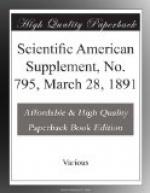There is no doubt that gas is the most convenient and in many ways one of the best forms of fuel for heating and cooking purposes, and the efforts which all large gas companies are now making to popularize and increase the use of gas for such purposes will undoubtedly bear fruit in the future. But before the day can come for gas to be used in this way on a large scale, there is one fact which the gas manager and gas stove manufacturer must clearly realize and submit to, and that is that no gas stove or gas water heater, of any construction, should be sent out or fitted without just as great care being taken to provide for the carrying away of the products of combustion as if an ordinary fuel range was being fitted. Do not for one moment allow yourself to be persuaded that, because a gas stove or geyser does not send out a mass of black smoke, the products of combustion can be neglected and with safety allowed to mingle with the atmosphere we are to breathe.
Scarcely a winter passes but one or more deaths are recorded from the products of combustion given off from various forms of water heaters used in bath rooms; scarcely a cookery class is given, with gas stoves, that one or more ladies do not have to leave suffering from an intense headache, and often in an almost fainting condition. And the same cause which brings about these extreme cases, on a smaller scale causes such physical discomfort to many delicately organized persons that a large class exist who absolutely and resolutely decline to have gas as an illuminant or fuel in any of their living rooms; and if the use of gas, more especially as fuel, is to be extended, and if gas is to hold its own in the future against such rivals as the electric light, then those interested in gas and gas stoves must face the problem, and by improving the methods of burning and using gas do away with the present serious drawbacks which exist to its use.
The feeling has gradually been gaining ground in the public mind that, when atmospheric burners and other devices for burning coal gas are employed for heating purposes, certain deleterious products of incomplete combustion find their way into the air, and that this takes place to a considerable extent is shown by the facts brought forward in a paper read by Mr. William Thomson before the last meeting of the British Association.
Mr. Thomson attempted to separate and determine the quantity of carbon monoxide and hydrocarbons present in the flue gases from various forms of gas stoves and burners, but, like every other observer who has attempted to solve this most difficult problem, he found it so beset with difficulties that he had to abandon it, and contented himself with determining the total amounts of carbon and hydrogen escaping in an unburned condition, experiments which showed that the combustion of gas in stoves for heating purposes is much more incomplete than one had been in the habit of supposing, but his experiments give no clew as to whether the incompletely burned matter consisted of such deleterious gases as carbon monoxide and acetylene, or comparatively harmless gases, such as marsh gas and hydrogen. After considerable work upon the subject, I have succeeded in doing this by a very delicate process of analysis, and I now wish to lay some of my results before you.




